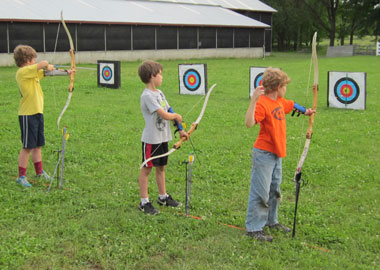Arm guard in place, I straddle the line left foot first. I nock the arrow, pointing it down toward the grass; hold the bow loosely but confidently with just two fingers and my thumb; look up toward the target 30 feet away, and raise the bow. As I take a long, deep breath to gain what I hope will be calming focus, I listen carefully as Kyle talks me through the process. Pull back the string, but not too much. Keep my right wrist straight. Don’t angle the string. Anchor my right hand to my cheek. Keep my left arm straight. Close my left eye. Aim the tip of the arrow a foot in front of the target. Breathe and focus. Don’t think about it. Look through my right eye down the tip of the arrow to the target ahead. Breathe one more time. Let it go.
In the hoops jargon of former ESPN sportscaster Keith Olbermann, “Release. Rotation. Splash.”
Bullseye.
I let my arms down slowly, trying not to grin too complacently as I look back at Kyle.
“Wow!” he laughs enthusiastically.
I can’t believe I shot a bullseye. “You’re a good teacher,” I quip, not having shot a bow and arrow since summer camp a generation ago. “I should probably just stop here,” I add, knowing that after my brief flirtation with success it is unavoidable that I will endlessly over-think the rest of my shots.
Still smiling for me, Kyle turns his attention back to the students in his class, and I happily load another arrow.
I don’t hit another bullseye for the rest of the session.
“Shooting becomes non-shooting, a shooting without bow and arrow,” Eugene Herrigel wrote in his classic treatise Zen in the Art of Archery. “The teacher becomes a pupil again, the master a beginner, the end a beginning, and the beginning, perfection.”
I’m participating in the second class in the late spring Thursday evening session of the Amherst Archery Academy. There are eight or so students, mostly kids around 10 years old, and two adults, one of them a father taking the class with his daughter, the other a woman of more advanced age who tells me she is considering setting up a shooting range in her back yard.
Classes take place on a beautiful field at Bramble Hill Farm in South Amherst. The field is next to a barn, which is used for target storage and as an indoor space in case of inclement weather. Between the open sky above, with the setting sun caressing the western horizon, and the panoramic view of the Holyoke Range to the south, the setting is extremely picturesque. You could do nothing but stand there for the entire hour-and-a-half session, just looking around and enjoying the scenery, and the time would not be wasted.
Classes are taught by Kyle Forbes Bissell, who started the Academy last spring. A physical education teacher at the Common School by day, Kyle has, over the years, accrued a lifetime of experience as an instructor of various outdoor recreations, including skiing, rock climbing and canoeing. He received a master’s degree in education from Lesley University and holds a Level I USA Archery certification.
“I teach Olympic-style target archery as a recreation sport and tool for self-awareness and personal growth,” Kyle notes at his academy’s website (kyleforbesbissell.com). “My instructional philosophies and practices encourage patience, persistence and peace.”
It is clear that, for Kyle, the goal of archery is more than the bullseye.
He explains that archery, like other outdoor recreations, provides a practice in which its participants can find their natural flow. But unlike other pursuits, such as rock climbing or whitewater kayaking, “you get this real immediate feedback, but at little consequence.”
It’s the feedback that is the key educational element. “What can participants learn from this experience and then transfer to other parts of their life?” Kyle asks.
In kyudo, he tells me, traditional Japanese archery uses small targets that are more difficult than conventional targets to hit, “because the goal isn’t the external target.”
“Archery can help people find their center,” he tells me, “on the target, as well as inside themselves.”
After the students help him gather their gear and set up the range, Kyle begins the class by shooting six arrows, emphasizing the process of calmly focusing on each step for each arrow.
“While you are at the line,” he instructs, “you get to see the connection to the bow, and also to yourself.”
It’s encouraging to see the calming effect this has on his students, most of whom are kids who seem happy enough just running around and chasing each other over the extensive farm field. It’s also reassuring to know that I won’t be standing mere feet away from out-of-control kids wielding bows and arrows.
The first class of each session is 80 percent instruction and only 20 percent shooting, whereas the rest of the classes are mostly shooting, based on that day’s instruction. Having joined the group on what is only their second class of the session, I find it impressive to see how smoothly the routine is already running.
As I look down the line at the various participants in the class, it occurs to me that there’s a unique aspect to archery: it is equally accessible to and enjoyable for practitioners of all ages, abilities and levels of athleticism. There’s an entry point for every potential student of archery, regardless of experience.
Nocking my next arrow, I take another deep breath, draw the bow, anchor my hand, aim and release. The arrow hurls itself through the air.
And I know it won’t be long before I return to the archery range.



